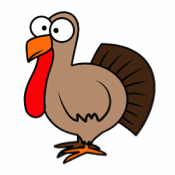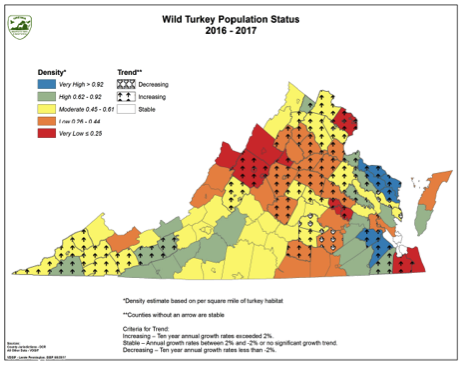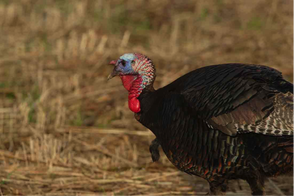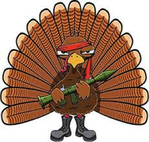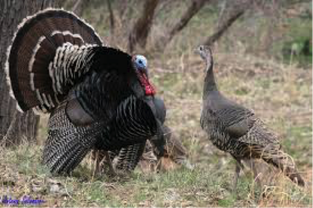|
By Jeff Stehm As November arrives it is time to pull out our binoculars and cameras and go gawk at the gobblers, otherwise known as Meleagria gallopavo silvestris or the eastern wild turkey. With some luck, a little study, and observation (and a judicious reading of this blog) you’ll be able to wow your Thanksgiving Day guests! Range, Habitat and Food Wild turkeys currently exist in 49 states (yes, Hawaii; no Alaska), southern Canada and Mexico. They have historically ranged throughout North America. However, by the early 20th century, hunting and habitat destruction had reduced the population to about 30,000. Conservation efforts in the 1950s and 1960s brought the current population back to about 6-7 million, although in some states (Mississippi and Arkansas) their numbers are declining because of habitat loss. In Virginia, wild turkeys number about 180,000 to 200,000 with the higher concentrations found in the Tidewater, South Mountain, and South Piedmont regions. Source: Wikipedia Source: VA DGIF The home range of individual birds in the spring can be as much as 3 – 4 square miles, shrinking to as little as 50 acres in the winter. In terms of habitat, wild turkeys prefer hardwood and mixed conifer-hardwood forest with areas of pasture, fields, orchards, and seasonal marshes. Of course our beloved Blue Hills fit this bill. Planting nut and berry trees is a good way to encourage turkey populations as well as practices such as prescribed burning, forest thinning, and grazing. One of the reasons for their extensive range in North America is the wild turkey’s opportunistic foraging. Wild turkeys are omnivores. While they prefer acorns, nuts and other hard seeds, they also eat berries, roots, insects, and the occasional amphibian, small reptile and small snake. This ability to feed on a range of food sources allows wild turkeys to survive in different areas of the country. Characteristics and Life History Turkey communities consist of toms (adult males), jakes (juvenile males), hens (females) and poults (young chicks). Toms weigh from 17-21 pounds and 40 inches tall, and hens weigh 8-11 pounds and 30 inches tall. A Jake in Pennsylvania, Source: US FWS (Photo: Bill Buchanan/USFWS) An interesting anatomical feature of the toms is the snood – an adornment that dangles from between the eyes. The snood can change color and length based on the tom’s excitement. Turkeys walk a lot and are not known for their flight ability, but they can fly up to 55 mph in short bursts and can run at 18 mph. At night, turkeys will fly into trees to spend the night as protection from predators. Turkeys have acute eyesight and hearing, but poor taste and smell. Turkeys’ eyes are located on the sides of their head, giving them monocular vision. They compensate by turning their heads to better judge distance. This is combined with excellent hearing allowing turkeys to locate the source of a sound with uncanny ability. Field studies suggest turkeys hear at lower frequencies and can hear more distant sounds than humans. Turkeys’ key defense against predators, therefore, is their sight and hearing. In sum, don’t move when a turkey is looking and don’t think about moving when they’re not. At times, turkeys can also be aggressive in self-defense against predators, if cornered, or if defending territory. Mating and Nesting. Mating season is March to June and nesting occurs from mid-April to mid-June. Nesting sites are on the ground, typically in native bunchgrasses, forbs, or shrubs between 20-26 inches tall. Nests are a shallow depression or bowl scratched out from the dirt. Hens lay between 9-13 eggs over a two-week period. Incubation takes about 28 days. Poults take about two weeks before they are able to fly up into trees for protection, and hence are vulnerable to predation during this early period. Survival Rates and Predators. Studies indicate that only 10 to 50 percent of nests successfully hatch and then only about 25-50 percent of poults will make it beyond 4 weeks. Most of this loss is due to predators such as foxes, skunks, raccoons, possums, crows, hawks, and some snakes. Fun Facts about Wild Turkeys
Hope you enjoyed this brief romp through gobbler land! References/Further Reading VA Department of Games and Inland Fisheries https://www.dgif.virginia.gov/wildlife/turkey/ Wild Turkey – Wikipedia https://en.wikipedia.org/wiki/Wild_turkey Wild Turkey Life History, Cornell Ornithology Lab www.allaboutbirds.org/guide/Wild_Turkey/lifehistory Eastern Wild Turkey https://wildlife.tamu.edu/wildlifemanagement/eastern-wild-turkey National Wild Turkey Federation www.nwtf.org Wild Turkeys https://thevlm.org/portfolio_page/wild-turkeys/ How to Draw a Turkey http://paolosaporiti.com/how-to-draw-a-turkey-step-by-step/
2 Comments
Bernardine c Olson
11/28/2019 08:43:09 am
Great read on Turkey Day. Maybe we should honor them and not eat them!
Reply
Jeff Stehm
11/30/2019 11:34:43 am
I saw 10 wild turkeys on Thanksgiving while on the way to friends to (sorry) eat domestic turkey.
Reply
Your comment will be posted after it is approved.
Leave a Reply. |
Have a blog or blog idea?
Let us know (click) Other Blogs
VA Native Plant Society - click Brenda Clement Jones - click John Muir Laws' Blog - click Megan's Nature Nook - click Categories
All
Archives
September 2023
Blog Administrator:
Kathleen A. VMN since 2018 |
